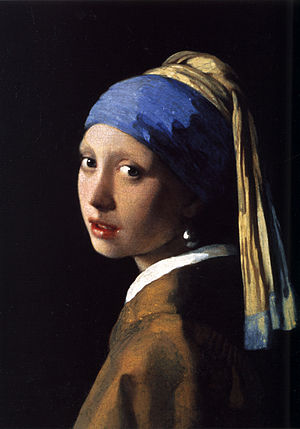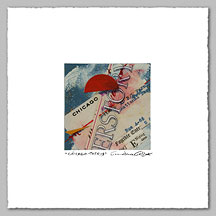Chiaroscuro, an Italian word which means light-dark, is used to describe shading in painting to reveal or conceal form. I love to take apart words, Chiaro, or clear or light. Reminds me in a way of Charro, the tiny hispanic spitfire dancer of the 70s. She was a bright one, funny, happy, sparky. Scuro, or obscured, hidden, shadow. This word got me to thinking about dark and light in others work as well as my own.
Here Jonathan Talbot added shadow after the collage pieces are set into place. This creates a sense of 3 dimensions where there are indeed only two.
Dianna Shyne allows the terra cotta soldiers to emerge from the earthy background. One can hardly tell where foreground and background begin and end, and the soldiers just rise up out of the field, nearly blending into each other as well.
_-_The_Girl_With_The_Pearl_Earring_(1665).jpg/300px-Johannes_Vermeer_(1632-1675)_-_The_Girl_With_The_Pearl_Earring_(1665).jpg)
Vermeer completely obscures the background in darkness,allowing the subject to become the only focus. There is plenty to look over, of course, in the one subject. She herself, fades into the darkness, her clothes, her head wrap and her neck all succumb to the darkness on the right side.
Georges de la Tour, master painter of candle light scenes. Here the foreground is obscured, revealing only a tiny portion of the scene in light. This is so theatrical and focused, and what a mood it creates: the subject’s posture, uncertainty, melancholy, and private-ness all contribute to the scene’s drama.

The way I work most often is like Jonathan Talbot, above. I layer materials to create images. In using this method, I’m not usually thinking very much about light-dark in terms of revealing form until the last step when I will choose a light source direction and add some highlights and shading. I tend to be more interested in how the chosen shapes, images, textures all work together on a 2 dimensional surface, and I’ve allowed light and shadow to be an afterthought. So now I’m wondering how different my work can be if I think about light-dark ahead of shapes, images and textures. In collage, it’s easier to just begin and not to plan ahead, but that’s not the only way to make collage work. And who says it has to be easy?
To bring this idea into a psychological realm, I’m thinking about how chiaroscuro could be used for emotional impact, to create mystery, or to obscure edges of things, people, and locations. To blend the edges of people into places, to blend the edges of people into each other. Where can I add mystery, create a sort of co-dependent painting….where do you end and I begin? If our edges or boundaries are in shadow, how can you tell where the edges are? I remember times in life and relationship when personal boundaries were obscured; in a way this ‘connection’ is comforting, but it’s also dark and binding. It took time and lots of talk therapy to change my perspective about personal connections, which has resulted in the way I live my life now, maintaining my relationships as interdependent, not co-dependent. There’s more darkness for me in that co-word, and more light in the inter-word.
“Love is heavy and light, bright and dark, hot and cold, sick and healthy, asleep and awake- its everything except what it is! (Act 1, scene 1)” ― William Shakespeare, Romeo and Juliet
Light and shadow. In a way, shadow in art reveals as much as light does, in that one can create focus by taking away the usual distractions of a scene by placing them in shadow. Is the glass half full or half empty, or is it half in the light and half in the shadow? Does the half in the shadow even exist? Who is in that shadow, anyway?
Idea sparkler for possible upcoming posts:
Sfumo, or smoke
light sources
hidden edges and edge issues
shades of gray



Leave a Reply